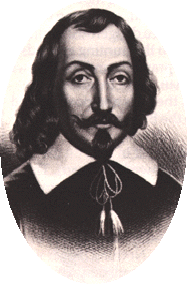
Samuel de Champlain
(1567-1635):

"Samuel Champlain was born at Brouage, a small seaport town in the old province of Saintonge, southeast of Rochefort and opposite the island of Oleron, about the year 1567."1 Little is known of Champlain's family background; indeed, though he wrote much, little personal information of Champlain's life is known. It is known, however, that Champlain learned the ways of the sea from his uncle.
Champlain's first substantial voyage, one to Spain, was with his uncle. This voyage led him to be on a chartered French vessel which went to the "West Indians and New Spain with the annual fleet." On his return to France two years later, the 32 year old Champlain was to link up with Francis Grave, Sieur du Pont (Pontgrave), a merchant, fur trader, and a citizen of St. Malo. The two of them, Pontgrave and Champlain, in 1603, voyaged together up the "riviere de Canada." Champlain, it would appear had no official position in this trading voyage. Pontgrave's business was at the trading post which had been established at Tadoussac. Leaving Pontgrave to his business, Champlain explored. He went "12 leagues" up the Saguenay; and then further up the St. Lawrence as far as Hochelaga (Montreal) passing on his way a place which in time he was to spend most all of his life (Quebec). Before the summer was out, Champlain returned to Tadoussac and embarked with Pontgrave for the return trip to France.
It was during this trip to Tadoussac and beyond that Champlain was to consider the advantages of Acadia. Not much was known of the American seaboard below the eastern shores of present day Nova Scotia. It was known to slope westward and I imagine that explorers like Champlain thought that following the American coast, southwest, might lead to the great western sea and the oriental riches beyond; at least it might lead to a shorter route to the lands and seas (Great Lakes) of which the Indians spoke and which they said was to the west of Hochelaga. (No one anticipated the eastern barrier as represented by the Alleghenies or more generally the great distances involved.) What Champlain likely concluded was that explorations in the southern parts of Acadia may lead to the discovery of a route to Asia, if not directly, then overland. Going up the St. Lawrence seem to lead to the thicker part of the continental barrier; and to Champlain's geographical eyes the continent seem to thin out as one went south. Besides: sought-after metals and mines were reported to exist in the southern parts of Acadia; and, the peltry trade could be carried on at the mouths of the endless number of rivers that flowed to the eastern seaboard of Acadia, a land, which, in 1600, included the shores of the present day State of Maine. (See map.)
Champlain came over with the de Monts expedition in 1605. A narrative of Champlain's adventures in Acadia is contained in my history of Acadia, in one of its very first chapters, "The Founding of Port Royal." Sufficient at this place to say that Champlain spent his first three winters in New France in Acadia. By September of 1607, Champlain and his fellow colonists in Acadia, due to lack of support from their French backers, returned to France.2 In July, 1608, however, Champlain was to be back up the St. Lawrence, having seemingly lost his optimism in respect to the possibilities of Acadia, taking with him a number of French colonists. Thus, Champlain, in 1608, founded Quebec, a French colony which, while slow to develop, was to become the French capital in North America.3
There is much more to Champlain than I have set forth, my interest being restricted to his involvement in the early days of Acadia. His fame lies principally due to his activities at Quebec where he laboured with the infant colony from 1608, until, on December 25th, 1635, this Father of Canada died.
FOOTNOTES:
[1] See works on Champlain, in particular those by Bourne and Grant, p. xiv.
[2] Ganong, Champlain's Island, p. 76.
[3] See Hannay, The History of Acadia at p. 110. Quebec's growth did not compare with the dramatic growth of the English colonies on the east coast of North America. By 1620, Quebec only numbered 60 souls; and by 1635, at the time of Champlain's death, Quebec was to consist of only 150 settlers. (DCB, vol. 1, p. 198.)